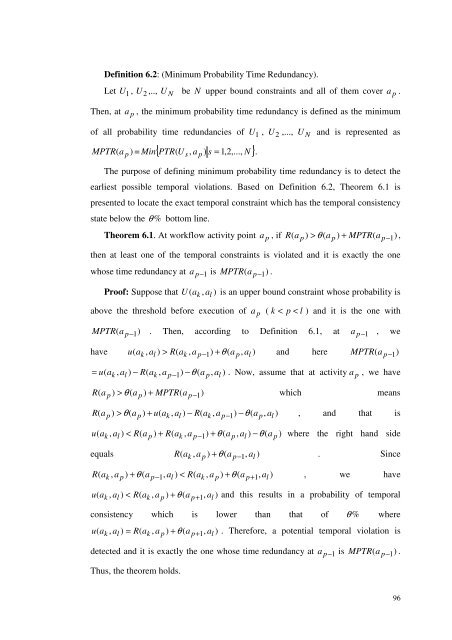Xiao Liu PhD Thesis.pdf - Faculty of Information and Communication ...
Xiao Liu PhD Thesis.pdf - Faculty of Information and Communication ...
Xiao Liu PhD Thesis.pdf - Faculty of Information and Communication ...
Create successful ePaper yourself
Turn your PDF publications into a flip-book with our unique Google optimized e-Paper software.
Definition 6.2: (Minimum Probability Time Redundancy).<br />
Let U 1 , U 2 ,.., U N be N upper bound constraints <strong>and</strong> all <strong>of</strong> them cover a p .<br />
Then, at<br />
a p<br />
, the minimum probability time redundancy is defined as the minimum<br />
<strong>of</strong> all probability time redundancies <strong>of</strong> U 1 , U 2 ,..., U N <strong>and</strong> is represented as<br />
MPTR ( a p ) = Min{ PTR( Us , a p ) s = 1,2,...,<br />
N}<br />
.<br />
The purpose <strong>of</strong> defining minimum probability time redundancy is to detect the<br />
earliest possible temporal violations. Based on Definition 6.2, Theorem 6.1 is<br />
presented to locate the exact temporal constraint which has the temporal consistency<br />
state below the θ % bottom line.<br />
Theorem 6.1. At workflow activity point<br />
a p , if ( a p ) > ( a p ) + MPTR(<br />
a p−1)<br />
R θ ,<br />
then at least one <strong>of</strong> the temporal constraints is violated <strong>and</strong> it is exactly the one<br />
whose time redundancy at a p−1<br />
is MPTR ( a p− 1)<br />
.<br />
Pro<strong>of</strong>: Suppose that U ( a k , a l ) is an upper bound constraint whose probability is<br />
above the threshold before execution <strong>of</strong><br />
a p ( k < p < l ) <strong>and</strong> it is the one with<br />
MPTR ( a p− 1) . Then, according to Definition 6.1, at a p−1<br />
, we<br />
have u( ak<br />
, al<br />
) > R(<br />
ak<br />
, a p−1)<br />
+ θ ( a p,<br />
al<br />
) <strong>and</strong> here MPTR ( a p− 1)<br />
= u( ak<br />
, al<br />
) − R(<br />
ak<br />
, a p− 1)<br />
−θ<br />
( a p,<br />
al<br />
) . Now, assume that at activity a p , we have<br />
R a ) θ ( a ) + MPTR(<br />
a )<br />
which means<br />
( p > p<br />
p−1<br />
R( ap<br />
p k l k p 1 p l<br />
) > θ(<br />
a ) + u(<br />
a , a ) − R(<br />
a , a − ) −θ(<br />
a , a ) , <strong>and</strong> that is<br />
u( ak<br />
, al<br />
) < R(<br />
a p ) + R(<br />
ak<br />
, a p−1)<br />
+θ ( a p,<br />
al<br />
) −θ<br />
( a p ) where the right h<strong>and</strong> side<br />
equals R( ak<br />
, a p ) +θ ( a p−1,<br />
al<br />
)<br />
. Since<br />
( a , a ) + θ ( a − , a ) < R(<br />
a , a ) + θ ( a 1,<br />
a ) , we have<br />
R k p p 1 l k p p+<br />
l<br />
u ( ak<br />
, al<br />
) < R(<br />
ak<br />
, a p ) + θ ( a p+<br />
1,<br />
al<br />
) <strong>and</strong> this results in a probability <strong>of</strong> temporal<br />
consistency which is lower than that <strong>of</strong> θ % where<br />
u ( ak<br />
, al<br />
) = R(<br />
ak<br />
, a p ) + θ ( a p+<br />
1,<br />
al<br />
) . Therefore, a potential temporal violation is<br />
detected <strong>and</strong> it is exactly the one whose time redundancy at a p−1<br />
is MPTR ( a p− 1)<br />
.<br />
Thus, the theorem holds.<br />
96
















